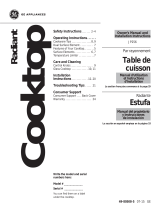
18
When the display shows the oven
is set in Sabbath. When the display
shows the oven is baking/roasting.
The Sabbath feature can be used for baking only. It cannot be used for broiling, self-cleaning, convection baking, steam cleaning or delay start cooking.
NOTE: The oven light comes on automatically (on some models) when the door is opened and goes off when the door is closed. The bulb may be removed. See
the Oven Light Replacement section. On models with a light switch on the control panel, the oven light may be turned on and left on.
+RZWR6HW6DEEDWK)HDWXUHIRU7LPHG%DNLQJ³,PPHGLDWH6WDUWDQG$XWRPDWLF6WRS
NOTE: To understand how the oven control works, practice
using regular (non-Sabbath) Immediate Start and Automatic
Stop before entering the Sabbath mode.
Make sure the clock shows the correct time of day and the
oven is off.
Touch and hold both the Bake and Broil Hi/Lo pads, at
the same time, until the display shows SF.
Tap the Clock pad (or Cooking Time pad for models
with no Clock pad) until SAb appears in the display.
Touch the Start/On pad and
will appear in the
display.
Touch the Cooking Time pad.
Touch the + or – pads to set the desired length of
cooking time between 1 minute and 9 hours and 59
minutes. The cooking time that you entered will be
displayed.
Touch the Start/On pad.
Touch the Bake pad. No signal will be given.
The preset starting temperature will automatically be
set to 350.° Tap the + or – pads to increase or
decrease the temperature in 25° increments. The
temperature can be set between 175° and 550.° No
signal or temperature will be given.
Touch the Start/On pad.
After a random delay period of approximately 30
seconds to 1 minute,
will appear in the display
indicating that the oven is baking/roasting. If
doesn’t appear in the display, start again at Step 7.
To adjust the oven temperature, touch the Bake pad
and tap the + or – pads to increase or decrease the
temperature in 25° increments. Touch the Start/On pad.
When cooking is finished, the display will change from
to
indicating that the oven has turned OFF but is still set in
Sabbath. Remove the cooked food.
Using the Sabbath feature. (on some models)
(Designed for use on the Jewish Sabbath and Holidays)
How to Set Sabbath Feature for Regular Baking
NOTE: To understand how the oven control works, practice
using regular baking (non-Sabbath) before entering
Sabbath mode.
Make sure the clock shows the correct time of day and the
oven is off.
Touch and hold both the Bake and Broil Hi/Lo pads, at
the same time, until the display shows SF.
Tap the Clock pad (or Cooking Time pad for models
with no Clock pad) until SAb appears in the display.
Touch the Start/On pad and
will appear in the
display.
Touch the Bake pad. No signal will be given.
The preset starting temperature will automatically be
set to 350.° Tap the + or – pads to increase or
decrease the temperature in 25° increments. The
temperature can be set between 175° and 550.° No
signal or temperature will be given.
Touch the Start/On pad.
After a random delay period of approximately 30
seconds to 1 minute,
will appear in the display
indicating that the oven is baking/roasting. If
doesn’t appear in the display, start again at Step 4.
To adjust the oven temperature, touch the Bake pad
and tap the + or – pads to increase or decrease the
temperature in 25° increments. Touch the Start/On pad.
NOTE: The Clear/Off and Cooking Time pads are active
during the Sabbath feature.
When the display shows the
oven is set in Sabbath. When the
display shows the oven is
baking/roasting.
How to Exit the Sabbath Feature
Touch the Clear/Off pad.
If the oven is cooking, wait for a random delay period
of approximately 30 seconds to 1 minute, until only
is in the display.
Touch and hold both the Bake and Broil Hi/Lo
pads, at the same time, until the display shows SF.
Tap the Clock pad (or Cooking Time pad for models
with no Clock pad) until ON or OFF appears in the
display. ON indicates that the oven will automatically
turn off after 12 hours. OFF indicates that the oven will
not automatically turn off. See the Special Features
section for an explanation of the 12-Hour Shutoff
feature.
Touch the Start/On pad.
NOTE: If a power outage occurred while the oven was
in Sabbath, the oven will automatically turn off and
stay off even when the power returns. The oven control
must be reset.
+
or
+
or
+
or






















